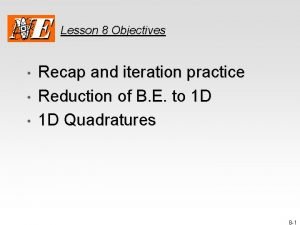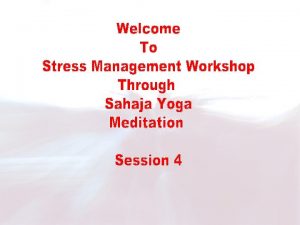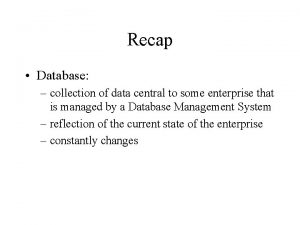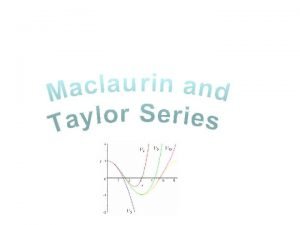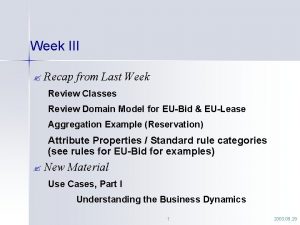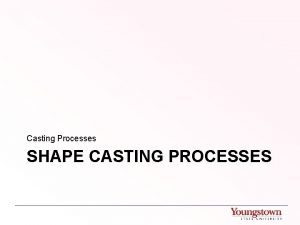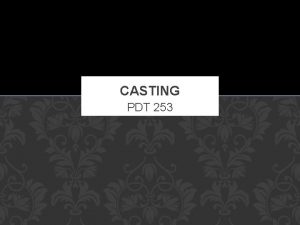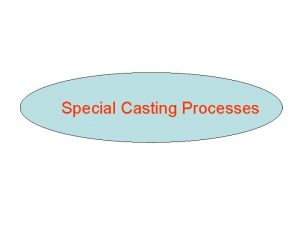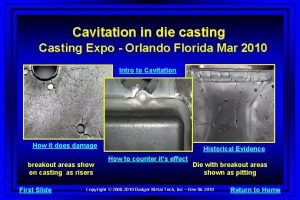RECAP CASTING TYPES OF CASTING ADVANTAGES OF CASTING


![Unit : 1 FORMING PROCESSES [ PRIMARY PROCESS] Sand casting • Molten metal is Unit : 1 FORMING PROCESSES [ PRIMARY PROCESS] Sand casting • Molten metal is](https://slidetodoc.com/presentation_image_h2/09572e11c8a97f03c0ad7c6905785caa/image-3.jpg)
![Unit : 1 FORMING PROCESSES [ PRIMARY PROCESS] Investment casting A pattern is made Unit : 1 FORMING PROCESSES [ PRIMARY PROCESS] Investment casting A pattern is made](https://slidetodoc.com/presentation_image_h2/09572e11c8a97f03c0ad7c6905785caa/image-4.jpg)
![Unit : 1 FORMING PROCESSES [ PRIMARY PROCESS] Advantages casting. Some of the materials Unit : 1 FORMING PROCESSES [ PRIMARY PROCESS] Advantages casting. Some of the materials](https://slidetodoc.com/presentation_image_h2/09572e11c8a97f03c0ad7c6905785caa/image-5.jpg)

![Unit : 1 FORMING PROCESSES [ PRIMARY PROCESS] Forging: This is the process that Unit : 1 FORMING PROCESSES [ PRIMARY PROCESS] Forging: This is the process that](https://slidetodoc.com/presentation_image_h2/09572e11c8a97f03c0ad7c6905785caa/image-7.jpg)
![Unit : 1 FORMING PROCESSES [ PRIMARY PROCESS] Types of forging Process Press forging Unit : 1 FORMING PROCESSES [ PRIMARY PROCESS] Types of forging Process Press forging](https://slidetodoc.com/presentation_image_h2/09572e11c8a97f03c0ad7c6905785caa/image-8.jpg)
![Unit : 1 [ FABRICATION PROCESSES] Welding: permanently Joining two pieces of metal together, Unit : 1 [ FABRICATION PROCESSES] Welding: permanently Joining two pieces of metal together,](https://slidetodoc.com/presentation_image_h2/09572e11c8a97f03c0ad7c6905785caa/image-9.jpg)

- Slides: 10

RECAP CASTING TYPES OF CASTING ADVANTAGES OF CASTING FORGING TYPES OF FORGING

Unit : 1 FORMING PROCESSES • Two type of forming processes. • Casting • Forging. Casting Pattern place in casting box: drag and cope Casting sand is ram on to the pattern until it fill the casting box. The pattern is taken out: a sand cavity is form in the casting box. Molten metal: iron or alloys is pour into the sand cavity. Molten metal cool down and takes the shape of the cavity.
![Unit 1 FORMING PROCESSES PRIMARY PROCESS Sand casting Molten metal is Unit : 1 FORMING PROCESSES [ PRIMARY PROCESS] Sand casting • Molten metal is](https://slidetodoc.com/presentation_image_h2/09572e11c8a97f03c0ad7c6905785caa/image-3.jpg)
Unit : 1 FORMING PROCESSES [ PRIMARY PROCESS] Sand casting • Molten metal is poured into a mould created in sand. The mould is made by a wooden pattern, and metal is poured through a hole in the sand. The mould is in two parts called a cope and drag, which are separated to remove the completed item. [ Petro bond sand, Parting powder, pattern, ingot Aluminium ] Products. Man-hole cover Car parts -? Reasons Dimensional accuracy is not vital. Can be used for large items. Die casting • Molten metal is forced under high pressure into a mould. The mould is usually made from two parts of hardened tool steel. Products Toy cars Reasons Large quantities of product dimensional accuracy need to be accurate
![Unit 1 FORMING PROCESSES PRIMARY PROCESS Investment casting A pattern is made Unit : 1 FORMING PROCESSES [ PRIMARY PROCESS] Investment casting A pattern is made](https://slidetodoc.com/presentation_image_h2/09572e11c8a97f03c0ad7c6905785caa/image-4.jpg)
Unit : 1 FORMING PROCESSES [ PRIMARY PROCESS] Investment casting A pattern is made from wax, which is then surrounded by clay or other ceramic materials. Once completed, molten metal is poured into the mould, sometimes with pressure applied. Product Compressor wheels Reasons Used for making complex shapes with a high degree of accuracy. Permanent mould casting The mould is made from metal, usually cast iron. A layer of heat-resistant clay is added to the inside of the mould to help release parts. Product Compressor wheels, Pressure valves , Gear wheels, and Engine pistons. Reasons Making products in large quantities, Products that can withstand high pressures.
![Unit 1 FORMING PROCESSES PRIMARY PROCESS Advantages casting Some of the materials Unit : 1 FORMING PROCESSES [ PRIMARY PROCESS] Advantages casting. Some of the materials](https://slidetodoc.com/presentation_image_h2/09572e11c8a97f03c0ad7c6905785caa/image-5.jpg)
Unit : 1 FORMING PROCESSES [ PRIMARY PROCESS] Advantages casting. Some of the materials used can be recycled. Can be cheaper especially for sand casting. Good surface finish. Complex and non complex shapes can be produce

https: //www. youtube. com/watch? v=SVUSJu. YQh. A 4 Sand casting https: //www. youtube. com/watch? v=Pj_mjj. UQad 8 Die casting
![Unit 1 FORMING PROCESSES PRIMARY PROCESS Forging This is the process that Unit : 1 FORMING PROCESSES [ PRIMARY PROCESS] Forging: This is the process that](https://slidetodoc.com/presentation_image_h2/09572e11c8a97f03c0ad7c6905785caa/image-7.jpg)
Unit : 1 FORMING PROCESSES [ PRIMARY PROCESS] Forging: This is the process that involves a metal being heated up and shaped by applying squeezing or compression force such as hammer blows on a hot metal over an anvil. During forging the metal undergo Plastic deformation - this is when a force is applied to a material it changes its shape or size permanently, even after the force has been removed. Forging improves the physical properties of a metal, by changing the direction of the grain flow- to improve, strength, toughness, and ductility. Types of forging Process • Drop forging A heated work piece is held in a fixed die. A hammer or upper die is then dropped, using gravity, on to the work piece to form it. [ Die is a mould made from metal] • Product • Engine cam shaft Reason High production rate. Used for small to medium-sized shapes. Good dimensional accuracy.
![Unit 1 FORMING PROCESSES PRIMARY PROCESS Types of forging Process Press forging Unit : 1 FORMING PROCESSES [ PRIMARY PROCESS] Types of forging Process Press forging](https://slidetodoc.com/presentation_image_h2/09572e11c8a97f03c0ad7c6905785caa/image-8.jpg)
Unit : 1 FORMING PROCESSES [ PRIMARY PROCESS] Types of forging Process Press forging Uses a slow squeezing action forming the heated work piece. This process is suitable for making large objects. Product Aircraft landing gear Reasons High production rate, used for large-sized shapes, Good dimensional accuracy, molten metal penetrates the whole object. Upset forging Usually one end of a bar needs to be shaped. The heated end of the work piece is gripped in a fixed die and then struck by a moving die with a hammer blow. Product Head of a bolt, socket screw, Reasons High production rate, Good dimensional accuracy,
![Unit 1 FABRICATION PROCESSES Welding permanently Joining two pieces of metal together Unit : 1 [ FABRICATION PROCESSES] Welding: permanently Joining two pieces of metal together,](https://slidetodoc.com/presentation_image_h2/09572e11c8a97f03c0ad7c6905785caa/image-9.jpg)
Unit : 1 [ FABRICATION PROCESSES] Welding: permanently Joining two pieces of metal together, this is done by using intense heat to fuse the metal together. Welding Process. MIG Welding - This is the most common industrial welding process , it uses electricity and gas to generate the heat that is needed to fuse the metal. MIG [Metal Inert Gas] Advantages: Suitable for large scale production. Different thickness of metal can be use Reduce cost: There is no need for extra cleaning. [Free from fumes and spatter] Oxy- Acetylene- Gas welding process uses flame produced by the mixture of two gases [Oxygen and acetylene] When the flame comes in contact with the welding rod it melts the rod forming a molten pool, allowing welding to take place

https: //www. youtube. com/watch? v=SVUSJu. YQh. A 4 Sand casting https: //www. youtube. com/watch? v=Pj_mjj. UQad 8 Die casting



